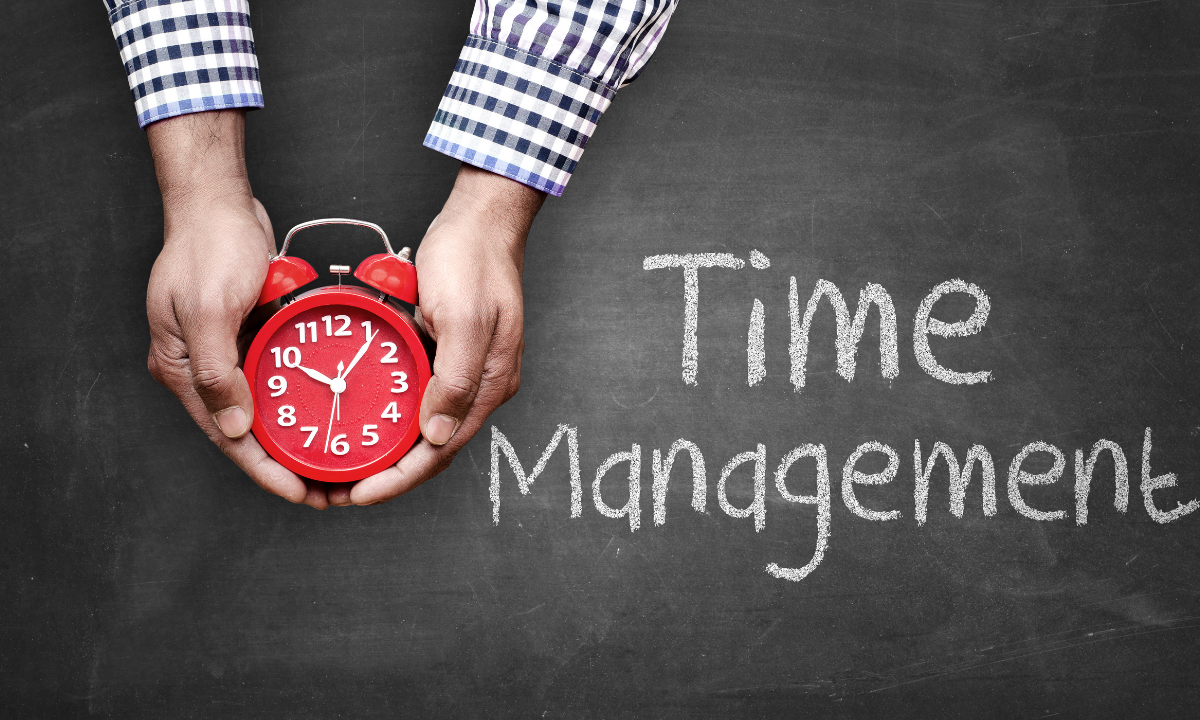
The question, "What role does goal setting play in your time management?" may seem unconventional, but from an HR perspective, it is deeply insightful.
Related Course: Free Time Management Course
As interviewers, we ask this question to assess your ability to plan, prioritize, and manage your tasks – all of which are crucial for productivity at work.
We are interested in understanding how you navigate your professional life and what strategies you resort to for balancing workloads and stringent deadlines.
The Purpose of the Question: What Role Does Goal Setting Play in Your Time Management?
Goal setting and time management are like two sides of the same coin; the former determines the direction, while the latter ensures you reach your destination efficiently.
The question aims to explore your planning abilities and your thought process behind setting and pursuing your professional goals. It digs into your organizational skills and your capacity to optimize resources, specifically the most limited one - time.
At What Interview Level is it Asked?
This compelling question usually surfaces at the intermediate to advanced stages of an interview, primarily for roles requiring project management, leadership skills, or where multi-tasking is part of the job description.
Interview Question: How Do You Define Successful Time Management?
Interview Question: How Has Time Management Helped in Meeting Deadlines?
Related Course: Leadership Course Online
However, it could also be asked to entry-level candidates, install the importance of effective time management right from the onset of their careers.
What Kind of Answer is Expected from the Candidate?
The interviewer expects a well-articulated narrative showcasing your natural ability to set realistic objectives and the steps you take to achieve them within a given timeframe. Your answer should reflect your foresight, discipline, and efficiency.
It will be beneficial to share instances where goal setting had a direct positive impact on your time management. But honest confession of times when you struggled, followed by the lessons learned, can also make your narrative more believable and human.
Possible Answers to Consider
"As a project manager, setting goals is an integral part of my time management. Every project begins with understanding objectives and setting a timeline for each deliverable. This process helps me prioritize tasks, monitor progress, and make necessary adjustments to stay on track."
"Goal setting plays an enormous role in my time management. At the start of every week, I set clear, achievable goals. I then break down these goals into tasks and assign a timeframe for each task. This has significantly improved my productivity and enabled me to manage my time effectively."
"Despite some hiccups in the early stages of my career, I soon understood the importance of goal setting for efficient time management. Now, I begin every project by setting S.M.A.R.T (Specific, Measurable, Achievable, Relevant, and Time-bound) goals. This not only provides me with a clear roadmap but also helps me evaluate my accomplishments."
In conclusion, goal setting and time management share a symbiotic relationship. They not only complement each other but are also interdependent.
As the world of work continues to evolve, the importance of understanding the role that goal setting plays in your time management only grows. Now equipped with this knowledge, you can stride confidently into your next interview, prepared to tackle this thought-provoking question head-on.
Remember, it's not about the hours you have; it's about what you do with them. Make every minute count. After all, "Time is what we want most, but what we use worst." - William Penn.
And as you set your goals and manage your time, remember to carve out some for yourself. Because at the end of the day, you're not just a task-machine, but a human, too.
Impact of Goal Setting on Time Management Efficiency
Comparison of Time Management Strategies with and without Goal Setting
Correlation between Effective Goal Setting and Successful Time Management
Similar interview questions:
How does setting goals influence your management of time?
Can you explain the influence of goal setting on your time management?
In what way does goal setting effect your time organization?
How critically is time management impacted by setting goals?
Could you put in perspective the connection between goal setting and time management
What's the significance of goal setting in managing your time effectively?
Could you highlight how goal setting interlinks with your time management?
In what capacity does establishing objectives contribute to your time management?
How directly does goal setting impact the way you manage your time?
Can you illustrate the role of goal setting in the context of time management?

Frequently Asked Questions
1. How do you prioritize tasks to ensure you meet your goals?
When prioritizing tasks, I always start by identifying the most critical and time-sensitive items on my to-do list. These are the tasks that have the greatest impact on achieving my goals and meeting important deadlines.
Aligning Tasks with Goals
I make sure to align each task with my overall goals and objectives. By understanding how each task contributes to the bigger picture, I can better prioritize and allocate my time and resources.
Breaking Down Large Projects
For larger projects, I break them down into smaller, manageable steps. This allows me to tackle the project in a systematic way and ensures that I make steady progress towards completion.
Staying Flexible and Adaptable
While I have a clear plan in place, I also remain flexible and adaptable. If urgent matters arise or priorities shift, I'm able to adjust my task list accordingly without losing sight of my ultimate goals.
Regularly Reviewing and Adjusting
I regularly review my progress and make adjustments as needed. This helps me stay on track and ensures that I'm always working on the most important tasks that will drive results.
By following this approach, I've been able to consistently meet my goals and deliver high-quality work, even under tight deadlines. It's a system that has served me well in both my personal and professional life, and I'm confident it will continue to do so in this role.
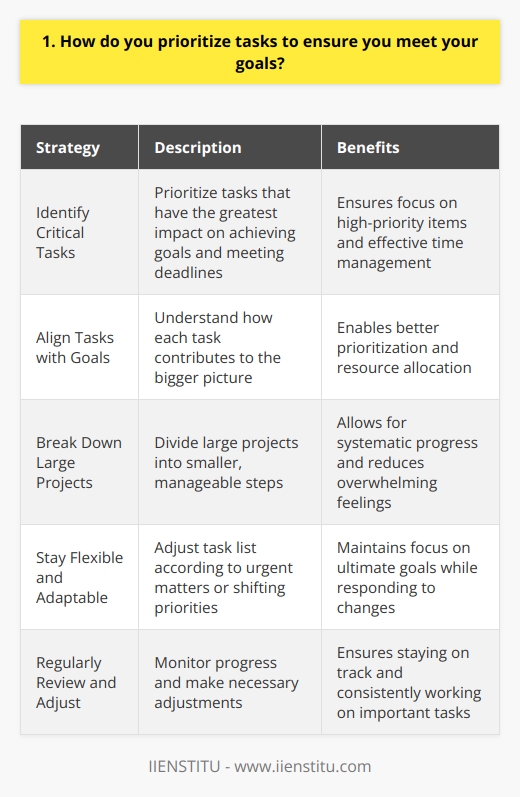
2. What strategies do you use to stay on track with your goals?
I have found that setting clear, achievable goals and breaking them down into smaller, manageable steps is crucial. This helps me stay focused and motivated, as I can track my progress and celebrate small victories along the way.
Prioritizing and Time Management
Effective prioritization and time management are essential for staying on track. I use tools like calendars, to-do lists, and project management software to organize my tasks and deadlines. By focusing on the most important and time-sensitive tasks first, I ensure that I'm making steady progress towards my goals.
Accountability and Support
Having an accountability partner or a support network can make a huge difference. I regularly share my goals and progress with a trusted friend or colleague, who helps keep me accountable and provides encouragement when I need it. Knowing that someone else is invested in my success is a powerful motivator.
Flexibility and Adaptability
Life can be unpredictable, and it's important to be flexible and adaptable when pursuing your goals. When faced with setbacks or unexpected challenges, I try to maintain a positive attitude and look for alternative solutions. By being open to adjusting my strategies and timelines as needed, I can stay on track even when things don't go according to plan.
Ultimately, staying on track with your goals requires a combination of clear planning, consistent effort, and a willingness to learn and adapt. By implementing these strategies and remaining committed to your vision, you can achieve remarkable things in your personal and professional life.
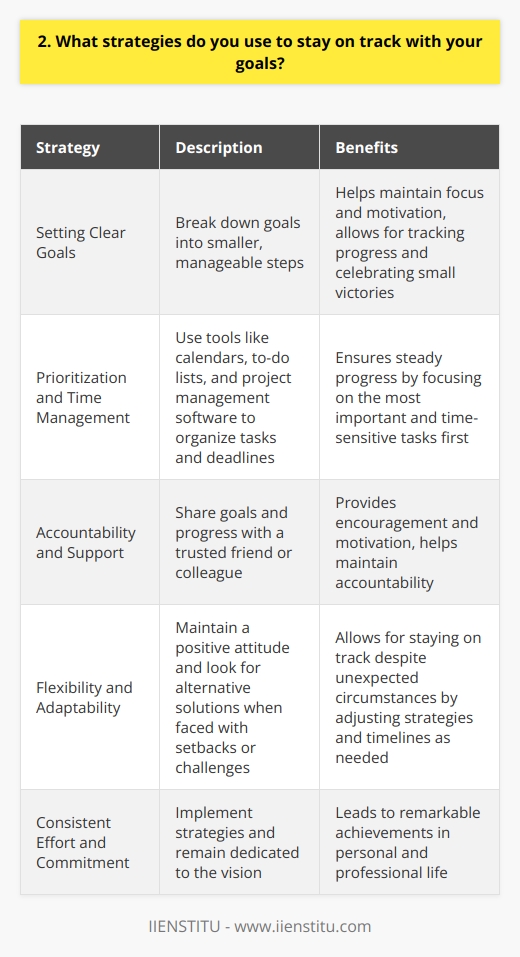
3. How do you break down larger goals into manageable tasks?
When tackling larger goals, I first assess the desired outcome and then break it down into smaller, manageable steps. This process helps me stay focused and motivated throughout the journey.
Prioritizing and Planning
I prioritize the tasks based on their importance and urgency, creating a clear roadmap to follow. Setting realistic deadlines for each milestone keeps me accountable and on track.
Collaboration and Delegation
Collaborating with teammates allows me to delegate tasks that align with their strengths, fostering a sense of shared ownership. Regular check-ins ensure everyone stays aligned and addresses any challenges promptly.
Celebrating Small Wins
Acknowledging and celebrating the completion of each task, no matter how small, boosts morale and maintains momentum. These victories serve as stepping stones towards the larger goal, keeping the team energized and committed.
Adapting and Adjusting
I remain open to adjusting the plan as needed, embracing flexibility in the face of unforeseen obstacles. By regularly reassessing progress and making necessary course corrections, I ensure the goal remains achievable.
Breaking down larger goals into manageable tasks is a skill I've honed over time. It's an approach that has consistently helped me tackle complex projects with confidence and deliver successful outcomes.
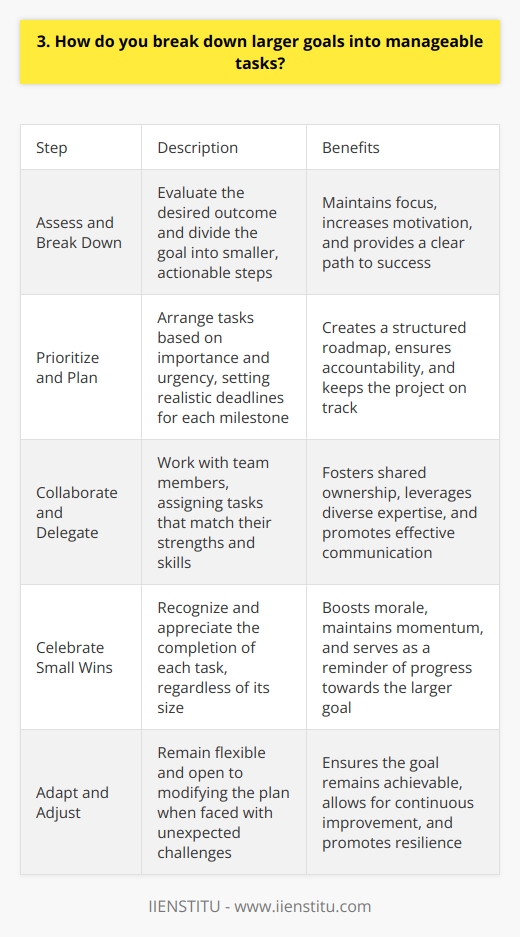
4. How do you handle competing priorities while working towards your goals?
When faced with competing priorities, I try to be organized and focus on high-impact tasks first. By carefully planning my work, I'm able to make steady progress towards my goals even when juggling multiple responsibilities.
Prioritization is key
The first step is to clearly identify what needs to get done and by when. I make a to-do list and prioritize the most important and time-sensitive items. Anything that directly impacts key goals or deliverables gets bumped to the top of my list.
From there, I block off time on my calendar to tackle each priority. If urgent issues arise, I re-assess my list and adapt as needed. Regular check-ins with my manager also help ensure I'm focusing my efforts in the right places.
Collaborating with the team
Handling competing priorities often requires working closely with colleagues. I strive to be a team player and proactively communicate my workload and deadlines. If I'm overloaded, I speak up and ask for help. We win and lose as a team, so it's important we support each other.
Staying flexible is a must
Even the best laid plans can go awry. I've learned to stay nimble and adjust course when priorities shift. Whether it's an unexpected fire drill or a last-minute request from a client, I try to remain calm and quickly re-align my work to address the most pressing needs. Staying focused yet flexible helps me consistently deliver strong results.
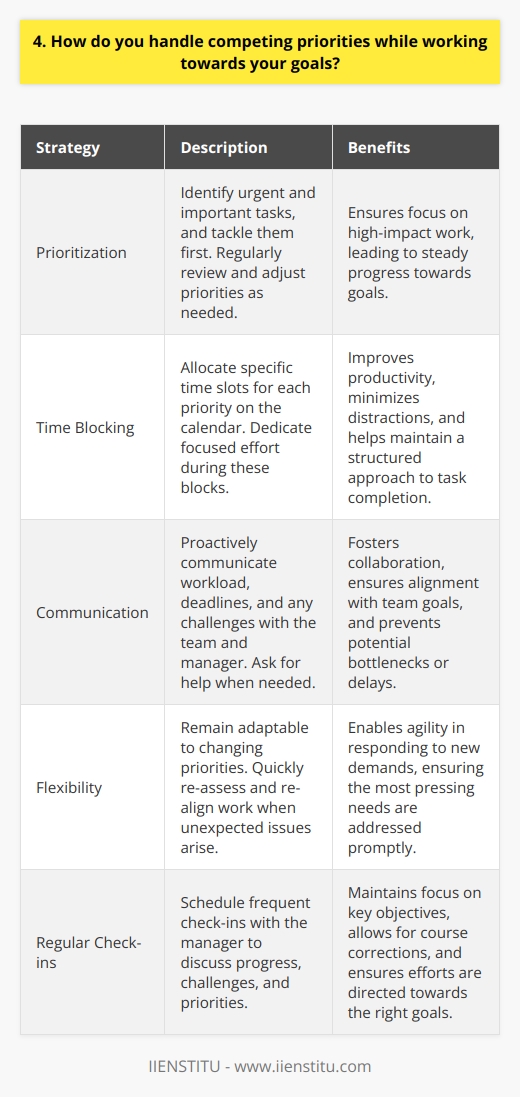
5. How do you measure progress towards your goals?
Measuring Progress Towards Goals
I believe that setting clear, measurable objectives is the foundation for tracking progress towards any goal. When I embarked on my recent project to redesign our company website, I broke it down into specific milestones with target dates. This allowed me to consistently gauge whether I was on track.
Regular check-ins are also crucial. I schedule weekly reviews to assess what I've accomplished, identify roadblocks, and course-correct if needed. For the website project, these frank self-assessments helped me stay focused and proactive.
Quantitative and Qualitative Metrics
I find using a mix of quantitative and qualitative indicators gives a holistic view of progress. With the website, I monitored hard numbers like page load speeds and conversion rates. But I also sought qualitative feedback from users about their experience. Together, these signals painted a meaningful picture.
Ultimately, I've learned that consistently measuring progress, even when it's uncomfortable, is what drives results. By facing the reality of where I stand, I can keep moving forward and achieve my goals, one well-planned step at a time.
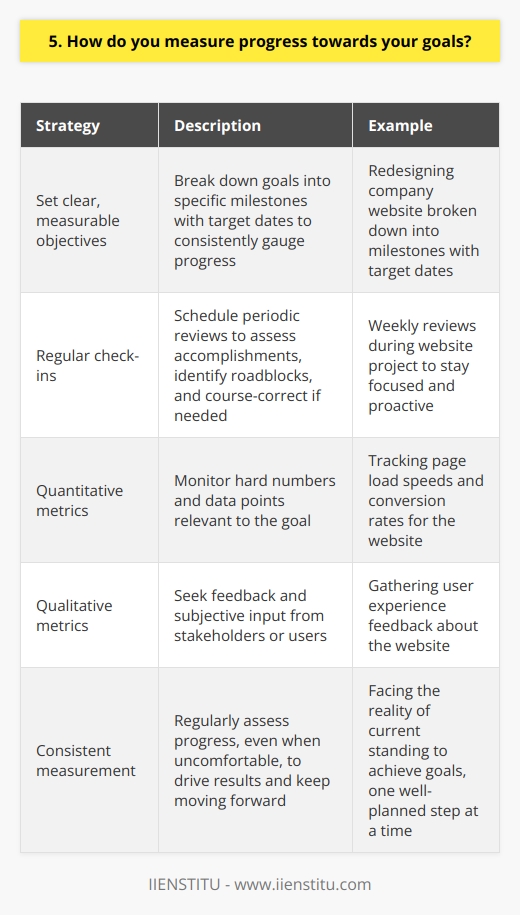
6. How often do you review and adjust your goals?
I make it a point to regularly review and adjust my goals, both short-term and long-term. This helps me stay focused, motivated, and on track to achieve what I set out to do.
Frequency of Goal Review
I find that reviewing my goals on a monthly basis works well for me. It's not so frequent that it becomes a burden, but it's often enough to keep my goals top of mind. If a particular goal requires more attention, I may check in on it weekly.
Adjusting Goals as Needed
Life is unpredictable, and sometimes our priorities or circumstances change. When this happens, I believe it's important to be flexible and adjust our goals accordingly. If I realize that a goal is no longer relevant or achievable, I'm not afraid to modify it or set a new one.
Learning from Successes and Failures
Each time I review my goals, I take the opportunity to learn from both my successes and failures. If I've made good progress on a goal, I analyze what strategies worked well so I can apply them to other goals. If I've struggled with a goal, I try to understand why and what I can do differently moving forward.
Celebrating Milestones
Finally, I believe in celebrating the milestones along the way to a larger goal. This helps keep me motivated and reminds me of the progress I've made, even if I still have a ways to go. Whether it's treating myself to a favorite meal or sharing my success with a friend, acknowledging these smaller victories is an important part of my goal-setting process.
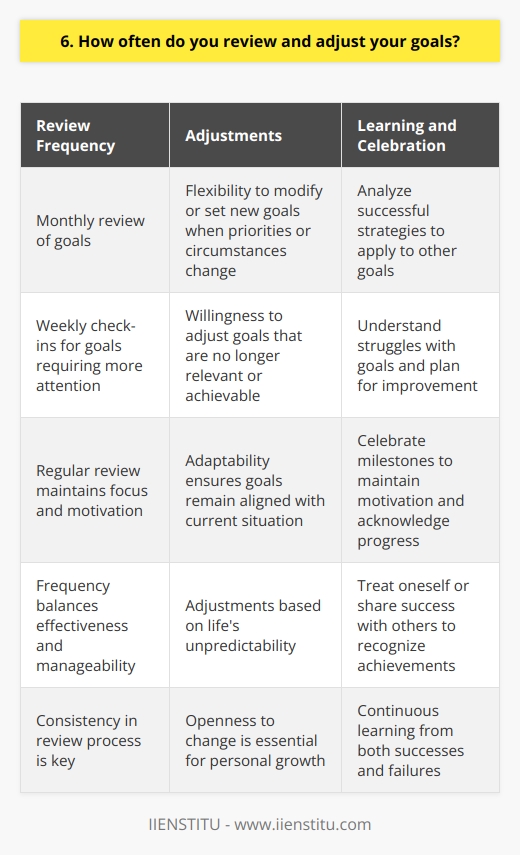
7. How do you stay motivated when working on long-term goals?
Staying motivated when working on long-term goals is all about maintaining perspective and celebrating small victories along the way. I find that breaking down big objectives into smaller, manageable tasks helps me stay focused and energized. When I achieve each milestone, I take a moment to acknowledge my progress and give myself a little pat on the back.
Find Your Why
Another key to staying motivated is connecting with your deeper purpose. I always ask myself, "Why am I pursuing this goal? What will it mean for my life and the lives of others?" When you have a clear sense of your "why," it's easier to push through challenges and setbacks.
Create a Support System
Surrounding yourself with supportive people can also make a huge difference. I'm lucky to have colleagues, mentors, and loved ones who believe in me and cheer me on. When I'm feeling discouraged, I reach out to them for encouragement and advice. Their positive energy helps me recharge and keep going.
Embrace a Growth Mindset
Finally, I try to embrace a growth mindset. Instead of getting frustrated by obstacles, I view them as opportunities to learn and grow. I remind myself that every challenge is making me stronger and bringing me closer to my ultimate goal. With patience, persistence, and a positive attitude, I know I can achieve anything I set my mind to.
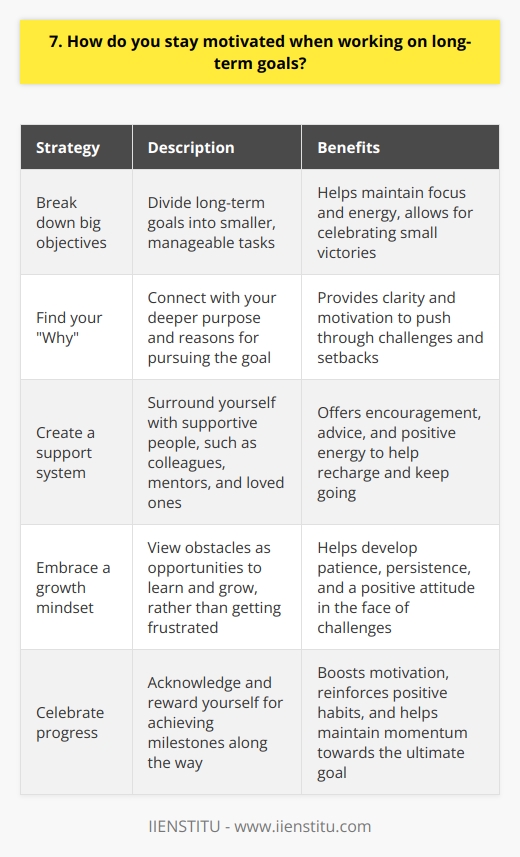
8. How do you handle setbacks or obstacles that hinder your progress towards your goals?
When faced with setbacks or obstacles, I take a step back and assess the situation objectively. I try to identify the root cause of the problem and brainstorm potential solutions. Collaboration is key, so I often reach out to colleagues or mentors for their insights and advice.
Staying Positive and Proactive
Maintaining a positive attitude is crucial. I view setbacks as opportunities for growth and learning. Instead of getting discouraged, I focus on what I can control and take proactive steps to overcome the challenge. Setting small, achievable goals helps me build momentum and stay motivated.
Adapting and Persevering
Flexibility is essential when dealing with obstacles. If one approach isn't working, I'm not afraid to pivot and try something new. I keep an open mind and embrace creative problem-solving. Perseverance is also vital – I don't give up easily. I keep pushing forward, even if progress is slow.
Learning from Setbacks
After overcoming a setback, I take time to reflect on what I've learned. I analyze what went wrong and identify areas for improvement. This helps me be better prepared for future challenges. I also celebrate my successes, no matter how small. Recognizing my progress keeps me energized and driven to reach my goals.
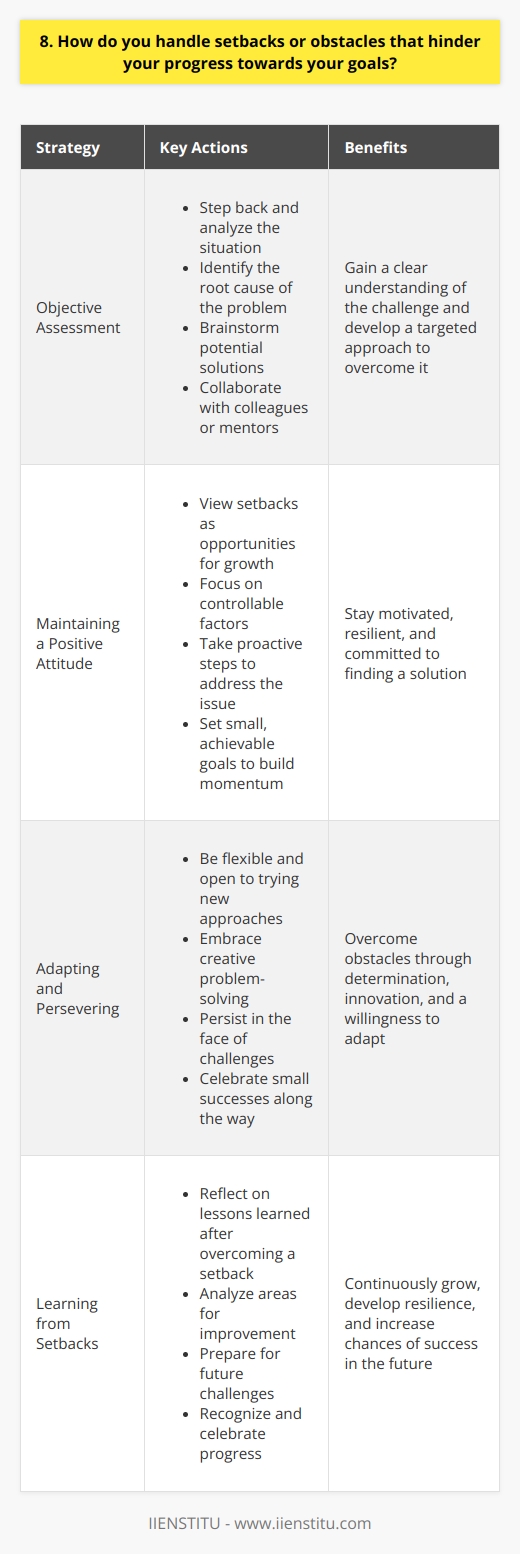
9. How do you ensure your daily activities align with your goals?
As someone who values efficiency and productivity, I have developed a system to ensure my daily activities align with my long-term goals. This approach helps me stay focused and motivated, even when faced with competing priorities or distractions.
Clarifying My Goals
I start by clearly defining my goals, both personal and professional. I break them down into smaller, achievable milestones. This process helps me visualize the path I need to take and identify the steps required to reach my objectives.
Prioritizing Tasks
Each day, I prioritize my tasks based on their relevance to my goals. I ask myself, "Which activities will bring me closer to achieving my objectives?" This question guides me in deciding where to focus my time and energy.
Tracking Progress
I regularly track my progress to ensure I'm staying on course. I use tools like to-do lists, calendars, and project management software to monitor my activities. This helps me identify areas where I may need to adjust my approach or allocate more resources.
Reflecting and Adjusting
I set aside time for self-reflection and evaluation. I review my progress, celebrate my successes, and learn from my challenges. If I find that certain activities are not contributing to my goals, I'm not afraid to make changes and refine my strategy.
By following this systematic approach, I am able to maintain a strong connection between my daily activities and my long-term objectives. It's a continuous process of planning, execution, and adaptation that keeps me motivated and on track towards achieving my goals.
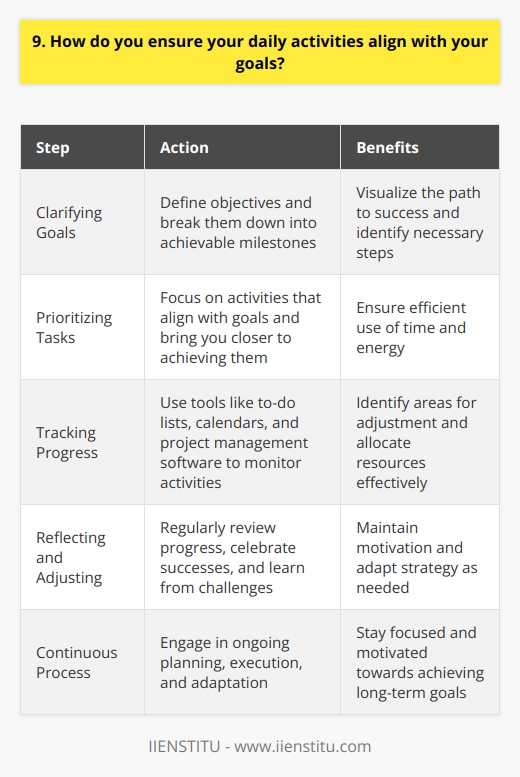
10. How do you balance short-term and long-term goals?
When it comes to balancing short-term and long-term goals, I believe in a strategic approach. I set clear priorities and create a roadmap that aligns with the company's vision.
Prioritizing Tasks
I assess the urgency and importance of each task and prioritize accordingly. Urgent tasks that contribute to long-term objectives take precedence. I also delegate when appropriate to optimize time management.
Example from my previous role
In my last job, I had to complete a time-sensitive project while also planning for the next quarter. I broke down the project into smaller milestones and allocated time for long-term planning. By focusing on one milestone at a time and regularly reviewing progress, I successfully delivered the project on time while laying the groundwork for future initiatives.
Adaptability and Flexibility
I understand that priorities can shift unexpectedly. I remain adaptable and ready to adjust my plans when necessary. Regular communication with my team and manager ensures alignment and allows for course corrections.
Continuous Learning and Growth
I dedicate time for personal and professional development, even amidst busy periods. Acquiring new skills and knowledge benefits both short-term performance and long-term career growth. I believe in lifelong learning and staying updated with industry trends.
Balancing short-term and long-term goals is a continuous process that requires planning, prioritization, and adaptability. By staying focused on the big picture while delivering on immediate responsibilities, I strive to contribute to the organization's success in the present and future.
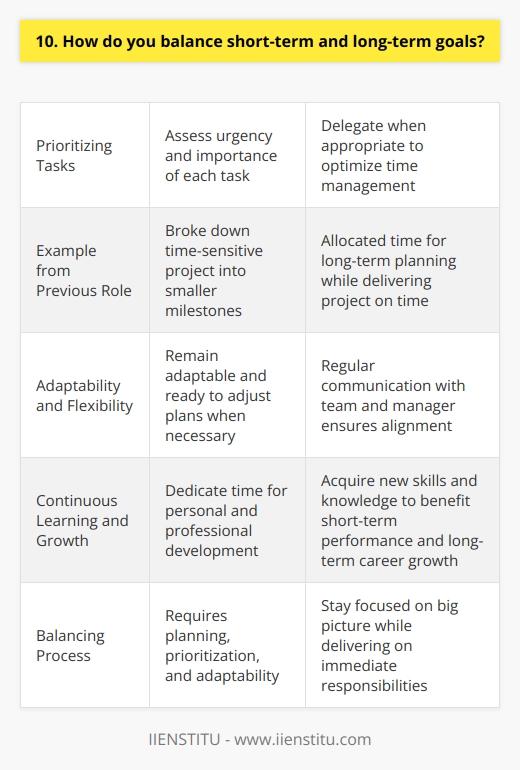
11. How do you determine realistic timelines for achieving your goals?
When determining realistic timelines for achieving my goals, I consider several key factors. First, I break down the goal into smaller, manageable tasks. This allows me to estimate the time required for each step more accurately.
Assessing Resources and Constraints
Next, I assess the resources available to me, such as time, budget, and team support. I also identify any potential constraints or obstacles that could impact the timeline, like dependencies on external factors or competing priorities.
Drawing from Past Experiences
Drawing from my past experiences helps me make informed estimates. I reflect on similar projects I've completed and consider the lessons learned to refine my timelines. For instance, when I led a website redesign project last year, I initially underestimated the time needed for user testing. By incorporating that knowledge, I can now allocate more time for testing in future projects.
Building in Buffers
I always build in some buffer time to account for unexpected challenges or delays. Life can be unpredictable, and I've learned that it's better to have a little extra time than to be caught off guard. This approach helps me stay on track and reduces stress.
Regularly Reviewing Progress
Finally, I regularly review my progress against the timeline. If I notice any deviations, I proactively adjust my plans and communicate with stakeholders. By staying flexible and adaptable, I can ensure that I'm moving towards my goals in a realistic and achievable manner.

12. How do you incorporate flexibility into your goal-setting process?
When setting goals, I always leave room for flexibility and adaptation. Life is full of unexpected challenges and opportunities, so it's essential to be ready to adjust course as needed.
Regularly Reassessing Priorities
I periodically take a step back to reevaluate my goals and priorities. As circumstances change, what once seemed important may no longer align with my values or long-term vision. By honestly assessing where I'm at, I can make necessary tweaks to stay on a meaningful path.
Staying Open to New Possibilities
While having specific goals provides direction and motivation, I try not to become too rigid in my thinking. Sometimes the most exciting opportunities arise when we least expect them. By cultivating a sense of curiosity and a willingness to explore new avenues, I've discovered passions and skills I never knew I had.
Learning from Setbacks
Inevitably, there will be obstacles and failures along the way. Rather than getting discouraged, I view these moments as valuable learning experiences. When a goal becomes unrealistic or a strategy isn't working, I pivot and adapt. Each setback teaches me something new about myself and helps me refine my approach moving forward.
Celebrating Small Wins
On the path to a larger goal, it's easy to overlook the smaller milestones. I make a point to acknowledge and celebrate these mini-victories. They serve as a reminder that progress is happening, even if the final destination still feels far away. Plus, enjoying the journey makes the whole process more fulfilling and sustainable.
Ultimately, I believe that flexibility is a strength, not a weakness, when it comes to setting and pursuing goals. By staying adaptable and open-minded, I'm better equipped to navigate life's twists and turns with resilience and grace.
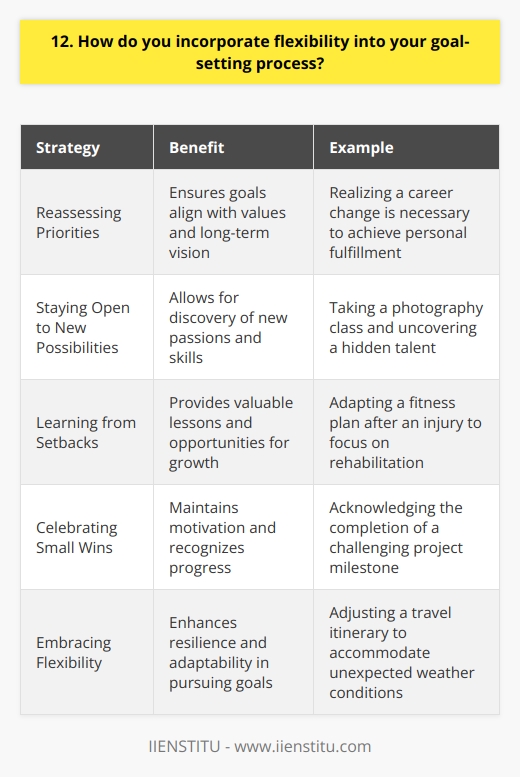
13. How do you use goal setting to improve your overall time management?
Goal setting is a crucial component of effective time management. I break down my goals into smaller, manageable tasks. This allows me to focus on one step at a time and make steady progress. I prioritize my tasks based on urgency and importance, ensuring that I tackle the most critical items first.
Tracking Progress and Adjusting Strategies
I regularly review my progress and assess whether I'm on track to meet my goals. If I find myself falling behind, I analyze the reasons and make necessary adjustments. This might involve reallocating time, seeking help, or finding more efficient approaches. By continuously monitoring and adapting, I can stay on course and achieve my objectives.
Balancing Short-Term and Long-Term Goals
I believe in maintaining a balance between short-term and long-term goals. While it's essential to focus on immediate deadlines, I also dedicate time to planning for the future. I set aside specific blocks of time for strategic thinking and developing long-term strategies. This helps me align my daily tasks with my overall career aspirations.
Leveraging Technology and Tools
I take advantage of various tools and technologies to streamline my time management. I use calendar apps to schedule appointments, set reminders, and block off dedicated work periods. Task management software helps me organize my to-do lists and track my progress. By leveraging these tools, I can stay organized and make the most of my time.
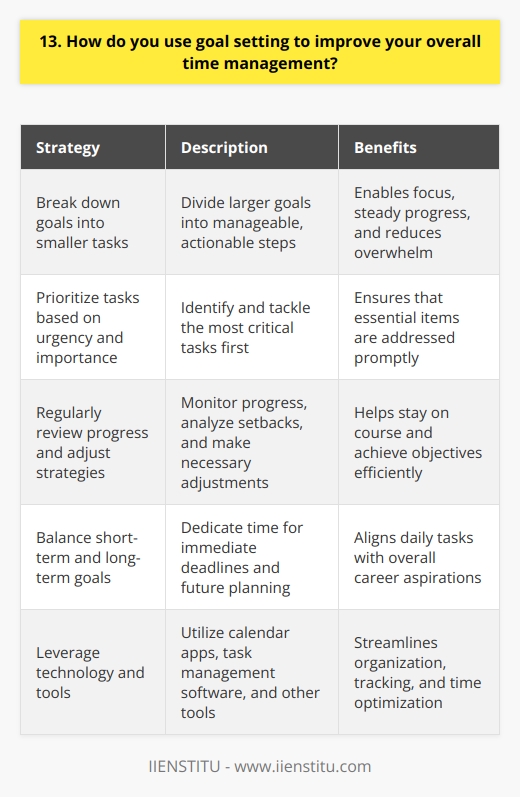
14. How do you communicate your goals to others when collaboration is necessary?
When collaborating with others to achieve a common goal, effective communication is key. I believe in setting clear expectations and objectives from the outset. This helps ensure everyone is on the same page and working towards the same end result.
Regular Check-Ins
I find that regular check-ins, whether in person or via email/chat, are essential for keeping projects on track. These touchpoints provide an opportunity to share progress updates, ask questions, and realign if needed. They also help build rapport and trust among team members.
Adapting Communication Style
Over the years, I've learned the importance of adapting my communication style to fit the preferences of my colleagues. Some respond best to detailed written updates, while others prefer a quick phone chat. By being flexible and attuned to individual needs, I'm able to keep everyone engaged and informed.
Leading by Example
As a team leader, I strive to lead by example when it comes to communication. I aim to be responsive, transparent, and proactive in my interactions. If challenges arise or timelines shift, I communicate this promptly to manage expectations. My goal is always to keep the lines of communication open and flowing.
At the end of the day, I believe successful collaboration hinges on clear, consistent communication. By setting expectations early, checking in regularly, and leading by example, I'm able to keep my team aligned and motivated to reach our shared goals.
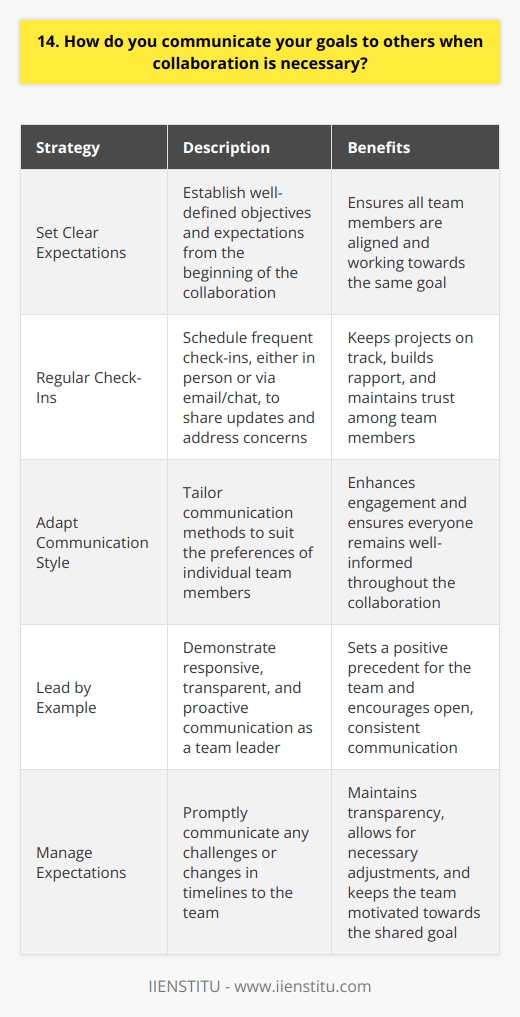
15. How do you use goal setting to maintain focus and avoid distractions?
I firmly believe that goal setting is crucial for maintaining focus and avoiding distractions. It helps me prioritize my tasks and stay on track. Here's how I approach it:
Break Down Big Goals into Smaller Milestones
When I have a large project, I break it down into smaller, manageable steps. This makes it less overwhelming and helps me stay motivated. I set deadlines for each milestone to keep myself accountable.
Create Daily To-Do Lists
Every morning, I make a to-do list of the tasks I need to accomplish that day. I prioritize them based on importance and urgency. Crossing items off my list gives me a sense of progress and achievement.
Minimize Distractions
I try to identify and eliminate potential distractions before they derail my focus. This might mean silencing my phone, closing unnecessary browser tabs, or finding a quiet workspace. When I'm tempted to procrastinate, I remind myself of my goals and why they matter.
Take Regular Breaks
Paradoxically, taking breaks can actually improve my focus. I use the Pomodoro Technique, working in 25-minute intervals with 5-minute breaks in between. This helps me avoid burnout and maintains my productivity over the long haul.
Review and Adjust
At the end of each day or week, I review my progress and assess whether I'm on track to meet my goals. If needed, I adjust my plan or timeline. Regularly checking in with myself ensures I stay aligned with my objectives.
By breaking down goals, minimizing distractions, and allowing time for breaks and reflection, I'm able to stay focused and avoid getting sidetracked. It's an approach that has served me well both personally and professionally.
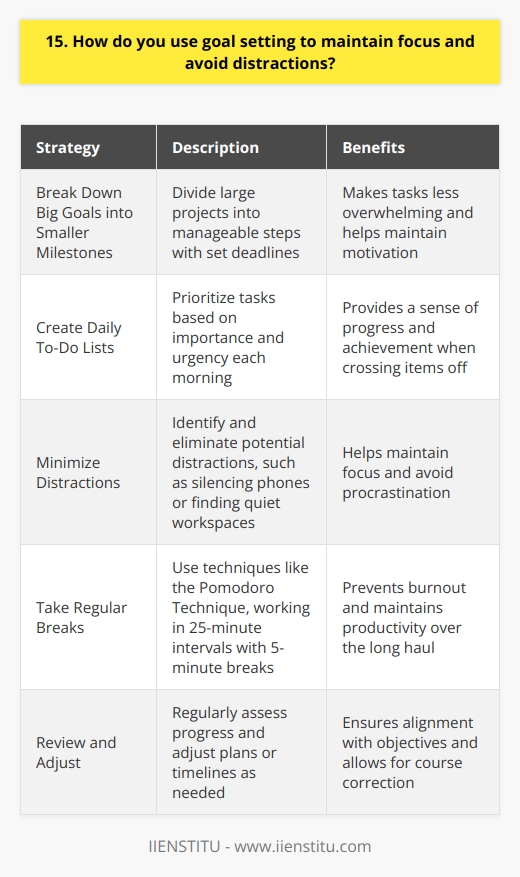
16. How do you ensure your goals are specific, measurable, achievable, relevant, and time-bound (SMART)?
When setting goals, I always strive to make them SMART. First, I ensure they are specific by clearly defining what I want to achieve. For example, instead of saying "improve sales," I would say "increase sales revenue by 20%."
Measuring Progress
Next, I make sure my goals are measurable. I identify key performance indicators that allow me to track my progress. Whether it's revenue, customer satisfaction scores, or project milestones, having quantifiable metrics is crucial.
Realistic and Achievable
I also consider whether my goals are achievable given my skills, resources, and time constraints. While I aim high, I make sure my targets are realistic. Setting unattainable goals can be demotivating, so I break them down into smaller, manageable steps.
Aligning with Priorities
Relevance is key when setting goals. I align them with my personal and professional priorities, as well as the company's objectives. By focusing on what matters most, I can make a meaningful impact and contribute to the organization's success.
Timeframes and Deadlines
Lastly, I make my goals time-bound by setting clear deadlines. Having a sense of urgency helps me stay motivated and focused. I break down long-term goals into smaller milestones with specific due dates to keep myself on track.
By following the SMART framework, I've been able to consistently set and achieve meaningful goals throughout my career. It's a proven approach that has helped me stay organized, motivated, and accountable.

17. How do you prioritize goals when faced with multiple important objectives?
When faced with multiple important objectives, I prioritize goals based on their impact and urgency. I consider which tasks have the greatest potential to drive success and address pressing needs.
Assessing Impact
First, I evaluate each goal's potential impact on the company's bottom line and strategic initiatives. Tasks that directly contribute to revenue generation or cost savings take priority. I also consider how each objective aligns with our team's KPIs and the organization's overarching mission.
Determining Urgency
Next, I assess the urgency of each task based on deadlines and dependencies. Goals with imminent due dates or those that other projects hinge upon get bumped up in priority. I've found that tackling the most time-sensitive items first helps keep everything on track.
Balancing Short-term and Long-term Objectives
It's important to strike a balance between short-term firefighting and long-term strategic planning. While urgent issues need swift resolution, I carve out time for tasks that contribute to big-picture goals. Neglecting either short-term or long-term objectives can ultimately hamper progress.
Staying Agile
Priorities can shift unexpectedly, so I stay nimble. I regularly reassess my to-do list and adjust course as needed. Communication is key here - I keep stakeholders informed of any changes in priority or timeline.
In summary, I prioritize by weighing impact and urgency, balancing short-term and long-term needs, and staying adaptable. This approach helps me consistently deliver results while driving the company's overarching strategy forward.
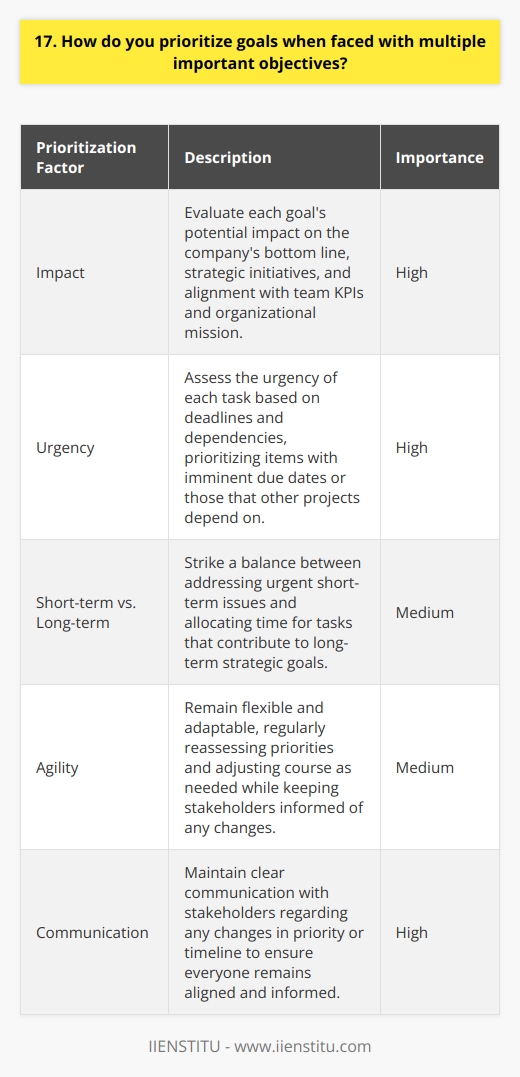
18. How do you celebrate or reward yourself when you achieve a goal?
When I achieve a goal, I celebrate in ways that are meaningful to me. I reflect on the journey and the lessons learned along the way. It's important to take a moment to appreciate the hard work and dedication that went into reaching the milestone.
Rewarding Myself
I like to reward myself with experiences rather than material things. For example, after completing a challenging project at work, I might treat myself to a weekend getaway or a day at the spa. These experiences allow me to unwind, recharge, and come back with renewed energy and focus.
Sharing the Joy
Celebrating with others is also important to me. When I achieve a personal goal, like running a marathon or learning a new skill, I share the news with my loved ones. Their support and encouragement mean the world to me, and celebrating together makes the achievement even sweeter.
Staying Motivated
Celebrating my successes, big and small, helps me stay motivated and focused on my goals. It reminds me that hard work pays off and that I am capable of achieving great things. By taking the time to acknowledge my achievements, I build confidence and momentum to tackle new challenges.
Looking Ahead
While it's important to celebrate the past, I also use these moments to look ahead to the future. I set new goals and think about what I want to achieve next. Celebrating my achievements is not just about patting myself on the back; it's about using that positive energy to propel myself forward and continue growing and learning.
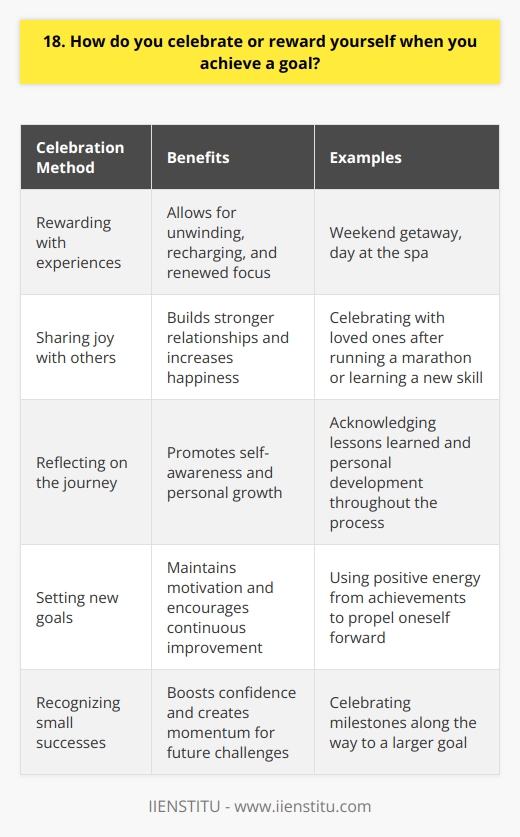
19. How do you use goal setting to identify areas for personal or professional development?
I use goal setting as a powerful tool for personal and professional growth. It helps me identify areas where I want to improve and guides my development journey.
Reflecting on Strengths and Weaknesses
I start by honestly assessing my current skills and performance. I consider my strengths that I can build upon, as well as weaknesses that may be holding me back. This self-awareness lays the foundation for meaningful goal setting.
Setting SMART Goals
Once I've pinpointed areas for development, I craft specific, measurable, achievable, relevant, and time-bound (SMART) goals. I find that having clear targets keeps me focused and motivated. For example, last year I set a goal to improve my public speaking by enrolling in a course and delivering three presentations.
Creating an Action Plan
With my goals defined, I break them down into concrete action steps. I map out the activities, resources, and support I'll need to achieve each milestone. Having a roadmap keeps me on track and allows me to celebrate small wins along the way.
Regularly Reviewing Progress
Goal setting is an ongoing process. I frequently assess my progress, noting both successes and setbacks. If I'm falling behind, I adjust my plan or seek guidance. Regular check-ins hold me accountable and ensure I'm always moving forward, even if the steps are small.
By leveraging goal setting, I've been able to significantly grow both personally and professionally. It's a proactive approach that puts me in the driver's seat of my own development. I'm excited to continue using this valuable tool to become the best version of myself.
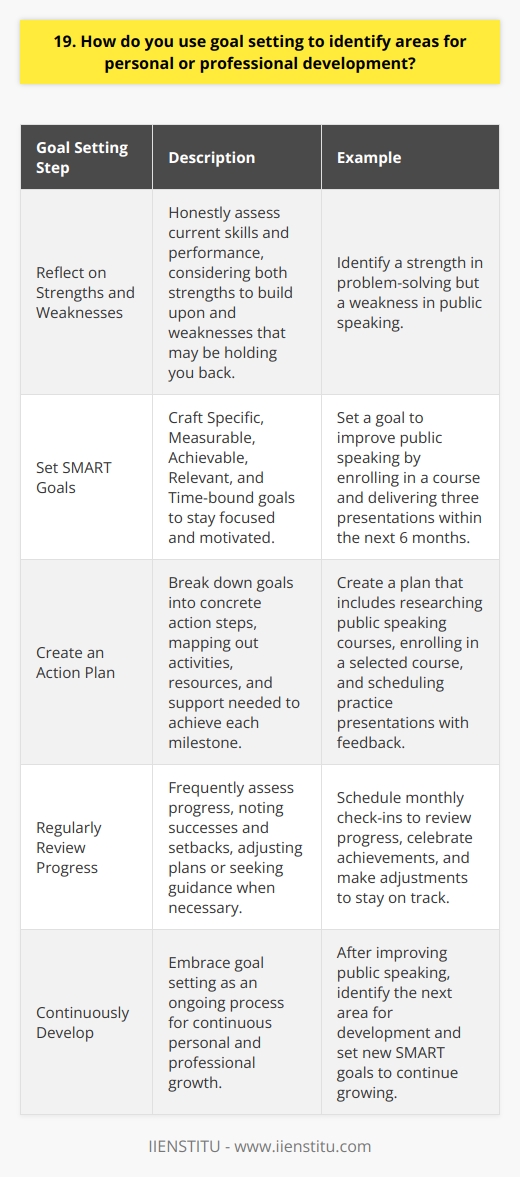
20. How do you align your goals with your organization's objectives?
When aligning my goals with an organization's objectives, I always start by thoroughly researching the company's mission and values. This helps me understand what drives the organization and how I can contribute to its success.
Understanding Company Objectives
I dive deep into the company's objectives, both short-term and long-term. By grasping these goals, I can better align my own aspirations with the organization's direction. It's about finding that sweet spot where my skills and passion can make the biggest impact.
Setting Personal Goals
Once I have a clear picture of the company's objectives, I set my own goals accordingly. I ask myself, "How can I use my strengths to help the company achieve its targets?" Whether it's developing new skills or taking on challenging projects, I'm always looking for ways to grow and contribute.
Collaborating with the Team
Aligning goals isn't a solo mission. It's about working closely with the team, exchanging ideas, and supporting each other. I believe that when everyone's goals are in sync, we can achieve incredible things together. It's like being part of a well-oiled machine, each cog playing its part to drive the company forward.
Staying Adaptable
In today's fast-paced world, objectives can change quickly. That's why I stay adaptable and ready to adjust my goals when needed. By being flexible and open to new challenges, I can ensure that my goals always remain relevant and aligned with the organization's evolving needs.
Ultimately, aligning my goals with the company's objectives is about being proactive, collaborative, and adaptable. It's an ongoing process that requires dedication and a genuine passion for the company's mission. And that's exactly what I bring to the table.
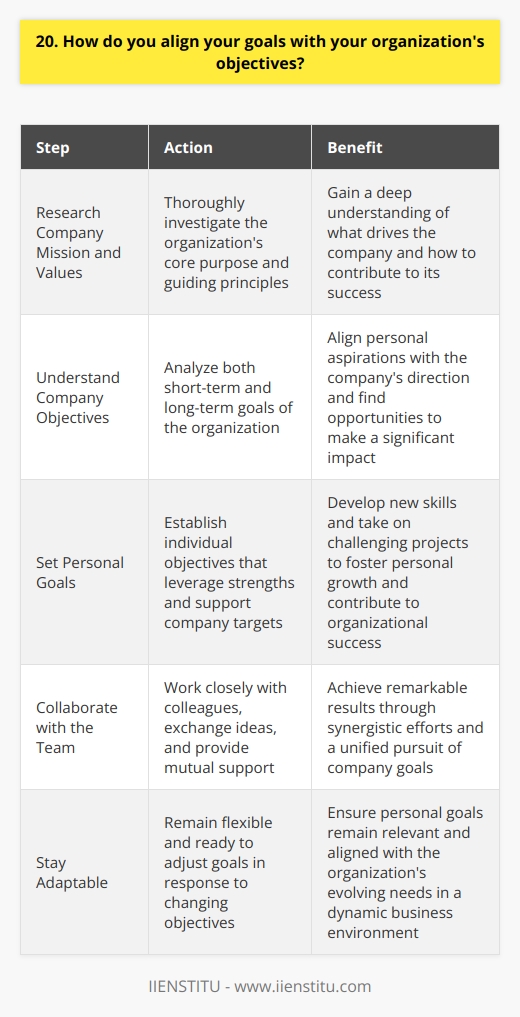
21. How do you use goal setting to optimize your productivity?
I believe goal setting is crucial for optimizing productivity. Here's how I approach it:
Set Clear, Specific Goals
I start by defining exactly what I want to achieve. I make my goals as specific as possible. Instead of just saying "improve sales," I set a target like "boost sales by 20% this quarter." Clear goals keep me focused and motivated.
Break Goals Down into Action Steps
Big goals can feel overwhelming. To make progress, I break them into smaller, manageable tasks. If my goal is launching a new product, I list out steps like market research, prototyping, gathering feedback, etc. Tackling one action at a time moves me forward without getting discouraged.
Prioritize and Schedule
With my action plan ready, I prioritize what's most important and time-sensitive. I block off time on my calendar to work on high-priority tasks. Scheduling keeps me accountable and ensures I make consistent progress, even when things get busy.
Track Progress and Adjust as Needed
I regularly check in on how I'm doing. Am I hitting my targets? If not, I consider why and make changes. Maybe I need to adjust my approach, get help, or revise the goal itself. Staying flexible keeps me on track.
In my experience, this goal-setting system boosts my productivity incredibly. It provides clarity, structure, and momentum to power through projects successfully. While it takes effort, the results are always worth it. I'm excited to bring this approach to your team.
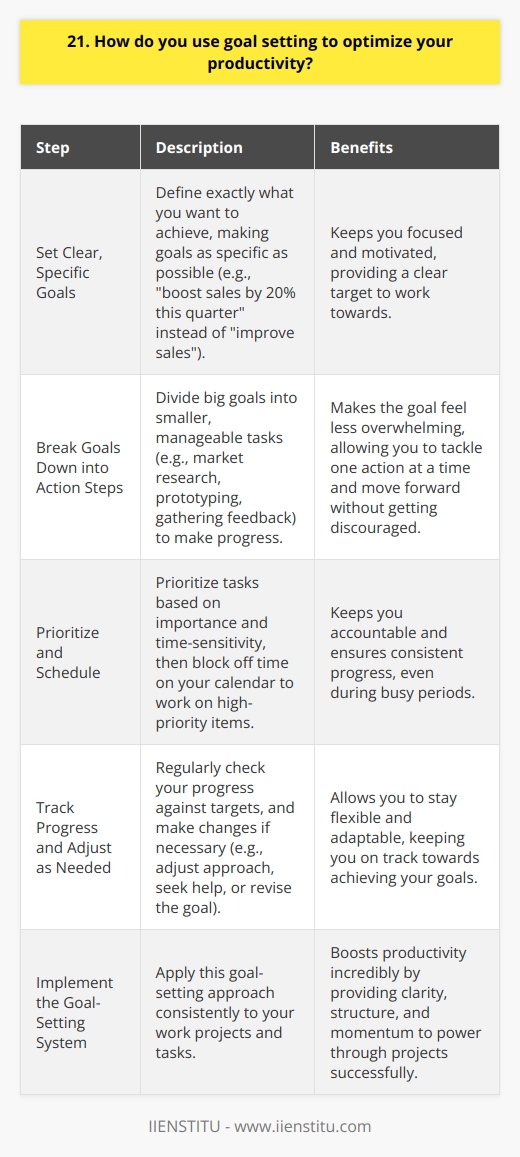
22. How do you ensure your goals are challenging yet attainable?
When setting goals, I always start by considering the big picture and what I ultimately want to achieve. This helps me identify meaningful objectives that align with my long-term vision. To ensure my goals are challenging yet attainable, I break them down into smaller, actionable steps.
Set Realistic Timelines
I assess the time and resources required for each step and set realistic timelines. This prevents me from getting overwhelmed or discouraged. I also build in some flexibility to account for unexpected challenges or setbacks.
Regularly Review Progress
Regularly reviewing my progress helps me stay on track and make adjustments as needed. Celebrating small wins along the way keeps me motivated. If I find a goal is too easy, I'll make it more ambitious. If it's proving too difficult, I'll reassess and modify my approach.
Seek Feedback and Support
I'm not afraid to seek feedback and support from colleagues, mentors, or friends. Their insights and encouragement can be invaluable. Collaborating with others also helps hold me accountable and pushes me to stretch myself.
Embrace Challenges as Opportunities
Ultimately, I view challenges as opportunities for growth and learning. Even if I don't fully achieve a goal, I always gain valuable experience and insights. The key is to set goals that inspire me to push beyond my comfort zone, while still being realistic about what I can accomplish with focused effort and determination.
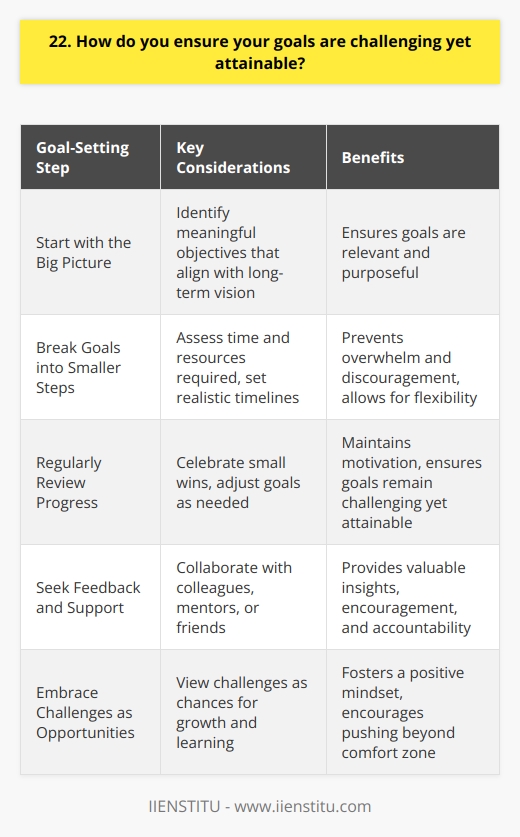
23. How do you use goal setting to maintain a healthy work-life balance?
I believe that setting clear goals is essential for maintaining a healthy work-life balance. To start, I establish specific, achievable objectives for both my professional and personal life. This helps me prioritize my time and energy effectively.
Scheduling and Boundaries
Once I have my goals in place, I create a schedule that allocates dedicated time for work and personal activities. I set firm boundaries around my working hours and communicate these expectations to my colleagues and loved ones. This ensures that I can focus on my job during work time and fully engage in my personal life outside of those hours.
Flexibility and Adaptability
While having a plan is crucial, I also remain flexible and adaptable. Life can be unpredictable, so I adjust my goals and schedule when necessary. If an unexpected work project arises, I might need to put in some extra hours temporarily. However, I make sure to compensate by taking time off later to recharge and spend quality time with family and friends.
Regular Review and Reflection
To stay on track, I regularly review my progress towards my goals. I reflect on what's working well and what areas need improvement. If I find myself consistently struggling to maintain a healthy balance, I reassess my goals and make adjustments. This ongoing evaluation helps me stay accountable and ensures that I'm not sacrificing my well-being for the sake of work.
By setting clear goals, creating a schedule with boundaries, remaining flexible, and regularly reviewing my progress, I've been able to maintain a healthy work-life balance. It's an ongoing process that requires effort and commitment, but the benefits – both personally and professionally – are well worth it.

24. How do you adapt your goals in response to changing circumstances?
I believe that adapting goals in response to changing circumstances is a crucial skill in both personal and professional life. When faced with unexpected challenges or opportunities, I first assess the situation objectively and gather relevant information. This helps me understand the potential impact on my existing goals and priorities.
Flexibility and Open-Mindedness
Being flexible and open-minded is key to adapting goals effectively. I try to embrace change and view it as a chance for growth and learning. By letting go of rigid expectations and considering alternative perspectives, I can identify new paths forward that align with my core values and long-term objectives.
Seeking Guidance and Support
When circumstances change significantly, I often seek guidance and support from mentors, colleagues, or trusted advisors. Their insights and experiences can provide valuable context and help me refine my goals in a thoughtful, strategic manner. Collaborating with others also reminds me that I'm not alone in navigating uncertainty.
Focusing on Progress over Perfection
As I adapt my goals, I focus on making steady progress rather than striving for immediate perfection. Breaking larger goals into smaller, achievable milestones helps me stay motivated and agile in the face of change. Celebrating small wins along the way boosts my confidence and resilience.
Continuous Learning and Reflection
Adapting goals is an ongoing process that requires continuous learning and self-reflection. I make time to assess my progress regularly, identify areas for improvement, and adjust my approach as needed. By staying curious and open to new ideas, I can turn changing circumstances into opportunities for personal and professional growth.
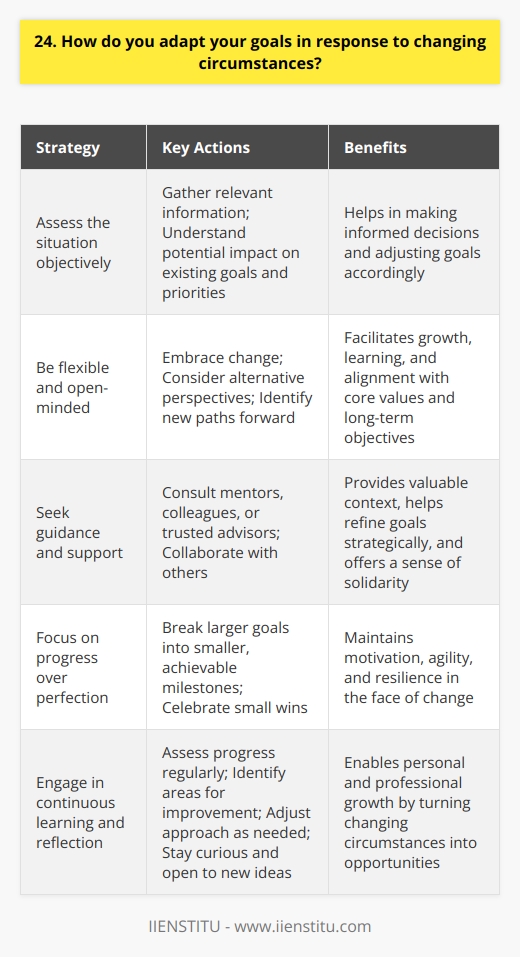
25. How do you use goal setting to identify and allocate the necessary resources for success?
Goal setting is a powerful tool for identifying and allocating resources effectively. When I set goals, I start by clearly defining what success looks like for each objective. This helps me determine the specific resources needed to achieve those goals.
Prioritizing Resources
Once I have a clear picture of the desired outcomes, I prioritize the resources based on their impact and urgency. I ask myself, "What are the most critical resources required to reach this goal?" By focusing on the essential resources first, I ensure that I'm allocating my time, energy, and budget wisely.
Breaking Down Goals
To make the process more manageable, I break down larger goals into smaller, actionable steps. Each step has its own resource requirements, making it easier to identify and allocate the necessary assets. This approach helps me stay organized and ensures that I'm making steady progress towards my objectives.
Monitoring and Adjusting
As I work towards my goals, I regularly monitor my progress and assess the effectiveness of my resource allocation. If I find that certain resources aren't contributing to my success as expected, I'm not afraid to make adjustments. Flexibility is key when it comes to optimizing resource utilization.
Collaboration and Delegation
I also recognize the importance of collaboration and delegation in achieving goals. By leveraging the skills and expertise of my team members, I can allocate resources more efficiently. I'm not afraid to ask for help or delegate tasks when it's in the best interest of reaching our shared objectives.
In my experience, effective goal setting and resource allocation go hand in hand. By clearly defining success, prioritizing resources, breaking down goals, monitoring progress, and collaborating with others, I've been able to consistently achieve my objectives while making the most of the resources available to me.

26. How do you involve others in your goal-setting process when appropriate?
When setting goals, I believe in the power of collaboration and involving others in the process. By seeking input from colleagues and stakeholders, I gain valuable insights that help shape my objectives. This inclusive approach not only leads to more well-rounded goals but also fosters a sense of shared ownership and commitment.
Gathering Diverse Perspectives
I make it a point to consult with team members who bring different experiences and expertise to the table. Their unique viewpoints often uncover aspects I may have overlooked, leading to more comprehensive and achievable goals. I remember a time when a colleague's suggestion completely reshaped my project's direction, resulting in a more impactful outcome.
Encouraging Open Dialogue
I create an environment where everyone feels comfortable sharing their thoughts and ideas. By actively listening and valuing each contribution, I encourage open and honest dialogue. This collaborative atmosphere not only strengthens the goal-setting process but also builds trust and rapport within the team.
Aligning Goals with Organizational Objectives
When involving others, I ensure that our goals align with the larger organizational objectives. By engaging with managers and stakeholders, I gain a clearer understanding of how my goals fit into the bigger picture. This alignment helps me prioritize and adjust my targets accordingly, ensuring that my efforts contribute to the company's overall success.
Continuous Refinement and Adaptation
Goal-setting is not a one-time event but an ongoing process. I regularly check in with my collaborators to assess progress, gather feedback, and make necessary adjustments. This iterative approach allows us to adapt to changing circumstances and ensures that our goals remain relevant and achievable.
In summary, involving others in my goal-setting process is a fundamental part of my approach. By leveraging diverse perspectives, encouraging open dialogue, aligning with organizational objectives, and continuously refining our targets, I create goals that are not only meaningful to me but also benefit the entire team and contribute to the company's success.
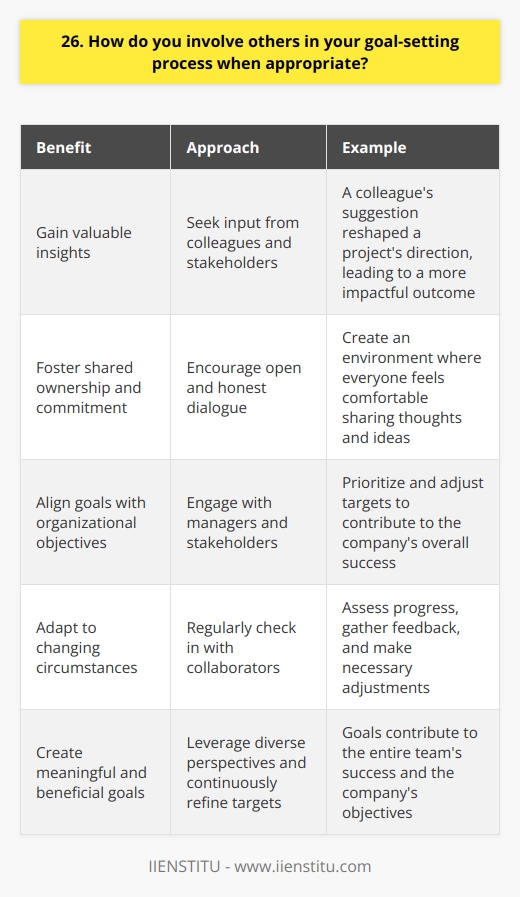
27. How do you use goal setting to prioritize self-care and personal well-being?
I believe that goal setting is crucial for maintaining a healthy work-life balance and personal well-being. By setting clear, achievable goals, I can ensure that I'm making time for the things that matter most to me outside of work, like spending quality time with my family, exercising regularly, and pursuing my hobbies.
Prioritizing self-care through goal setting
One of the ways I use goal setting to prioritize self-care is by scheduling dedicated time for activities that help me recharge and reduce stress, such as meditation, reading, or taking a relaxing bath. I find that when I make these activities a priority and treat them as non-negotiable goals, I'm much more likely to follow through and experience the benefits.
Setting boundaries and learning to say no
Another important aspect of goal setting for personal well-being is learning to set boundaries and say no when necessary. I've learned that it's okay to decline invitations or requests that don't align with my goals or values, even if it means disappointing others sometimes. By staying true to my priorities, I can avoid overcommitting myself and burning out.
Creating a support system
Finally, I've found that having a strong support system is essential for achieving my personal well-being goals. I make it a point to surround myself with positive, encouraging people who understand and respect my priorities. This could mean joining a fitness class with a friend who shares my health goals, or confiding in a trusted mentor when I'm feeling overwhelmed.
By setting intentional goals, prioritizing self-care, and cultivating a supportive network, I'm able to maintain a sense of balance and personal fulfillment even when faced with the demands of a busy career.

28. How do you use goal setting to foster a sense of purpose and direction in your work?
I believe goal setting is essential for maintaining a sense of purpose and direction in one's work. When I set clear, measurable goals, it helps me stay focused and motivated. I break down larger goals into smaller, achievable milestones to make steady progress.
Aligning Goals with Company Objectives
I always strive to align my personal goals with the company's objectives. This ensures that my efforts contribute to the overall success of the organization. By understanding how my role fits into the bigger picture, I find greater meaning and satisfaction in my work.
Regularly Reviewing and Adjusting Goals
I believe in regularly reviewing my goals and making adjustments as needed. Life and work are dynamic, and sometimes priorities shift. By staying flexible and adaptable, I can pivot when necessary while still maintaining a sense of direction.
Celebrating Milestones and Accomplishments
I think it's important to celebrate milestones and accomplishments along the way. When I achieve a goal, no matter how small, I take a moment to acknowledge my hard work and progress. This boosts my morale and motivates me to tackle the next challenge with renewed energy and enthusiasm.
In my previous role, I set a goal to improve our customer satisfaction ratings by 10% within six months. By breaking this down into smaller, actionable steps and collaborating with my team, we not only achieved that goal but exceeded it by an additional 5%. Celebrating this success together reinforced our sense of purpose and commitment to providing excellent customer service.
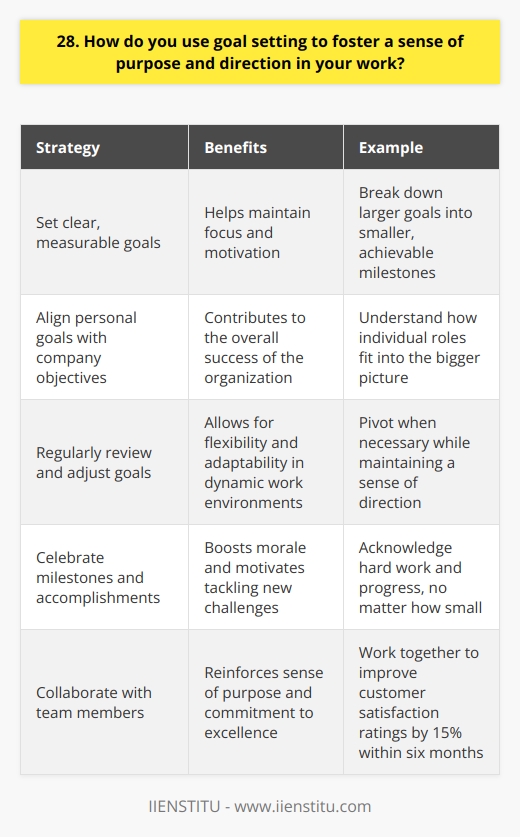
29. How do you use goal setting to identify and address potential roadblocks proactively?
I use goal setting to identify and address potential roadblocks proactively by following a systematic approach. This involves breaking down the overall goal into smaller, manageable tasks and milestones.
Anticipating Challenges
For each milestone, I try to anticipate the challenges that might arise. I draw from my past experiences and lessons learned to foresee potential hurdles. This helps me develop contingency plans and strategies to overcome those obstacles.
Collaborating with Stakeholders
I believe in collaborating with stakeholders to gather their insights and perspectives. Their input helps me identify blind spots and potential roadblocks that I might have overlooked. By involving them in the goal-setting process, I can proactively address their concerns and ensure everyone is aligned.
Continuous Monitoring and Adjustment
I regularly monitor progress towards the goal and assess the effectiveness of my strategies. If I encounter unexpected roadblocks, I quickly adapt my approach. I'm not afraid to make adjustments or course corrections when necessary to keep the project on track.
Celebrating Milestones
Celebrating milestones along the way keeps me motivated and energized. It's a reminder of the progress made and the obstacles overcome. These small wins boost my confidence and resilience in tackling future challenges.
By proactively identifying potential roadblocks and developing strategies to address them, I can minimize disruptions and ensure smoother progress towards achieving the goal.
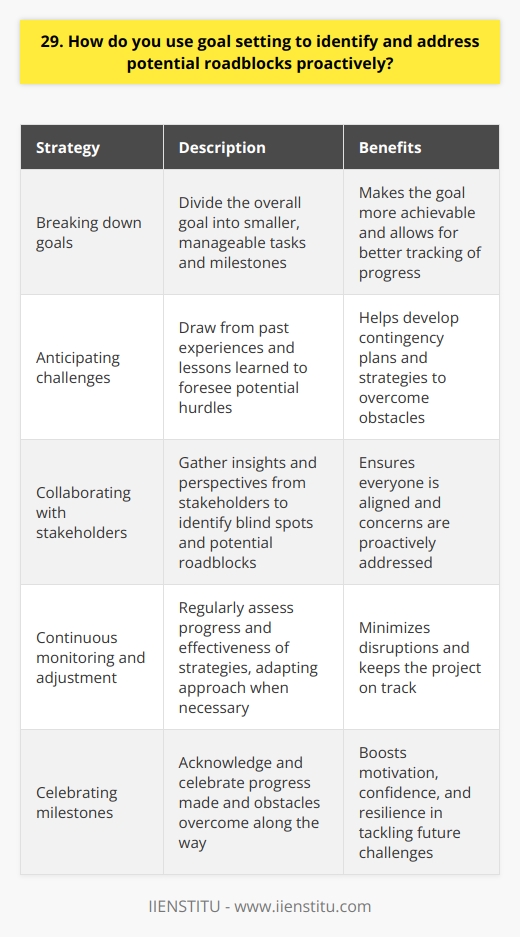
30. How do you use goal setting to maintain a positive and motivated mindset?
I use goal setting to maintain a positive and motivated mindset by following these strategies:
Set Specific and Achievable Goals
I break down my long-term objectives into smaller, manageable tasks. This helps me stay focused and motivated. For example, when I wanted to improve my public speaking skills, I set a goal to attend one Toastmasters meeting per month. Seeing progress towards my goals keeps me energized and positive.
Write Down and Visualize Goals
Putting my goals in writing makes them feel more tangible and real to me. I imagine how accomplished I'll feel when I achieve them. Before my first 10K race, I wrote "Run 10K in under 60 minutes" and pictured myself crossing the finish line. Having that clear mental image pushed me through the tough training runs.
Celebrate Small Wins Along the Way
I reward myself for making progress, not just reaching the final objective. When I was saving up to buy my first house, I treated myself to small splurges like a nice dinner out for every $1000 I put aside. Acknowledging those milestones helped me stay positive even though my end goal was months away.
Learn from Setbacks
If I face a challenge or roadblock, I try to view it as a learning opportunity rather than a failure. A few years ago, I launched a side business that ultimately didn't succeed. However, the skills I developed in digital marketing served me well in my next role. Knowing that setbacks can lead to growth keeps me motivated to keep striving towards my goals.



